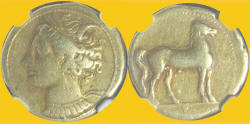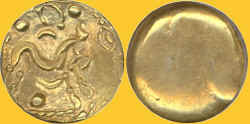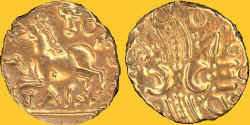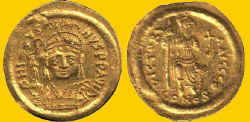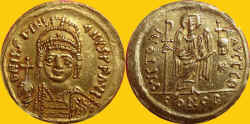This
is the Worldwide Numismatics Website!
Pictured here a few gold coins from the Ancient World
Click the thumbnail picture to see a larger version of the picture, then use your browser BACK button to return to the original page you were viewing.
Gold
Stater of Philip II minted in Macedonia circa 340 BC This stater was minted at the Pella Macedonian
mint during the reign of Philip II, father of Alexander the Great. The obverse
depicts the short haired head of the god Apollo. The reverse pictures a
galloping biga driven by a charioteer and the legend FILOPPOU in Greek with the
mintmark of a thunderbolt under the forelegs of the horses. This coin weighs
8,58 grams and is similar to SG-6663 (Seaby Greek Catalog). Gold
Stater of Alexander III ("the Great") minted in Macedonia circa 325 BC This stater was minted at a Macedonian mint
(Probably at the Amphipolis mint) during the reign of Alexander. The obverse depicts the head of the goddess
Athena in a Corinthian helmet. There is a symbolic snake on the helmet. The
reverse pictures a standing goddess Nike holding a victory wreath and a ship's
mast and the legend ALEXANDROU in Greek with
the mintmark of a shield to the left of Nike. This coin weighs 8,58 grams and is
cataloged as Price 176 and is similar to Muller751 and SG-6705. Gold Stater This stater was minted in
320-280BC in Zeugitana in electrum, a natural alloy of gold and silver. The
obverse has Tanit, the Sky goddess who ruled over the Sun, Stars and Moon.The
reverse depicts
a horse standing right, left foreleg drawn slightly back;
three
pellets beneath horse. Gold Stater This stater was minted in the Koson
area of Thrace by an unknown group believed to be of Scythian origin. Many
people attribute the coin to Brutus because the obverse features a scene found
on denarii issued under him in Rome, three figures in togas, one being Brutus
with two other ligates. Below the figures is the believed city's name KOSON in Greek. The
reverse has a depiction of an eagle standing on a sceptre holding a victory
wreath in its claw. The coin is cataloged as SG-1733. Gold
Aureus of Julius Caesar minted by A. Hirtius - 46 BC This aureus was minted in Rome by the moneyer
A. Hirtius to pay troops that fought under Caesar defeating the forces of Pompey
at Thapsus in North Africa during the civil war. The obverse is believed to
feature a veiled head of the goddess Pietas with the legend C CAESAR COS TER (Caius
Caesar Third Consulship) to the left. The reverse shows pontifical and augurship
emblems, the lituus and the axe with the legend A HIRTIUS PR (Aulus Hirtius
Praetor). Gaius Julius Caesar was born in 100 BC. He set himself up as Dictator
in 49 BC which was resented by leading Romans and which led to his assassination
in 44 BC. At one point he even issued coins inscribed as CAESAR DICT PERPETVO
(Caesar Perpetual Dictator). This coin weighs 8,22 grams and is SrM-1395. Gold
Stater of Ambiani Tribe This
uniface coin was minted by the Celtic Ambiani tribe during the Gallic War. This
tribe made its home near present day Amiens, France. Many of these coins are
found in Britain left there during the Gallic War against Caesar. The coin
features a large disjointed prancing horse with a crescent above and a pellet
below. The coin was issued between 58 to 55 BC and it weighs 6,25 grams.
Gold Quarter
Stater of Tasciovanos This quarter stater was minted in
Britain by the Celtic Catuvellauni tribe sometime between 20 and 5 BC. The coin
was apparently minted in Verlamion (present day St. Albans) as the letters VERO
are on the obverse in the quarters of the wreath. The reverse has a prancing
horse with the letters TAS below which is for the King Tasciovanus who reuled
the tribe from around 20BC until his death in 9 AD. This is a small coin, on;y
12,79mm weighing 1,37 grams. The coin is lisated as BMC 1646. Gold
Aureus of Tiberius circa 21-25
AD This aureus was minted in Lugdunum (present
day Lyon, France) . It features the same images that are on the famous Tribute
Penny mentioned in the Bible when the Jewish priests tried to entrap Jesus into
making an anti-Roman statement and He tactfully replied: "Render unto
Caesar the things which are Caesar's and render unto God the things that are
God's." The obverse has a laureate head of Tiberius facing right surrounded
by the legend TI CAESAR DIVI AVG F AVGVSTVS. The reverse includes a seated
female figure holding a spear and a branch believed to be the emperor's mother,
Livia, and the legend PONTIF MAX. Tiberius was born in 42 BC and ruled from 14
to 37 BC. This coin weighs 6,22 grams and is SrM-1760. Gold
Aureus of Nero circa 65-66 AD This aureus was minted in Rome. The obverse
has a laureated bust of Nero facing right with the legend NERO CAESAR AVGVSTVS.
The reverse has a seated figure of Salus, goddess of health and safety, holding
a patera with the legend SALVS. Nero was the emperor who, legend says, fiddled
while Rome burned. This great fire occurred in 64 AD. This coin was issued to
commemorate Nero's escape from the conspiracy of C. Calpurnius Piso. Nero
committed suicide in 68 AD. This coin weighs 7,16 grams and is listed as
SrM-1932. Gold
Solidus of Constantius II circa 351-355 AD This solidus was minted in Constantinople. The
obverse has a helmeted bust of Constantius facing forward with the legend FL IVL
CONSTANTIVS PERP AVGV . The reverse has a seated figures of Roma and
Constantinopolis holding a shield enscribed VOT XXX MVLT XXXX with the legend
GLORIA REI PVBLICAE. In the exergue
is the mintmark CONS. This coin weighs 4,40 grams and is similar to SR-3988 but
it has the AVGV legend (i.l.o. AVG) and the CONS mintmark. Gold
Solidus of Honorius circa 397-402 AD This solidus was minted in Constantinople, the
capitol of the Eastern Empire. The obverse features a bust of Honorius facing
right with the legend D N HONORIVS PF AVG. On the reverse we find a figure
representing Constantinopolis enthroned holding a sceptre and Victory standing on
a globe with the legend CONCORDIA AVGGG. Honorius was born in 384 AD. He
attained the rank of Augustus in 393 AD and acceded to the throne in 395 AD. He
had a tumultuous reign and died in 432 AD. During his rule, Alaric and the
Visigoths besieged Rome and finally sacked it in 410 AD. This coin weighs 4,40
grams and is listed as RIC-8. Gold
Solidus of Justin I circa 518-527 AD This solidus was minted in Constantinople, the
capitol of the Eastern Empire. The obverse features a bust of Justin facing
right with the legend D N IVSTINVS PF AVG. On the reverse we find a figure of
the standing emperor hold a long sceptre and a cross. The officina
is Theta. This coin weighs 4,16
grams, has a diametre of 19,6 mm and is listed as Sear-345. Gold
Solidus of Justinian I circa 527-565 AD This solidus was minted in Constantinople, the
capitol of the Eastern Empire. The obverse features a bust of Justinian facing
forward with the legend D N IVSTINIANVS PF AVG. On the reverse we find a figure of
a standing angel hold a long sceptre and a cross. The officina
is Theta. This coin weighs 4,21
grams, has a diametre of 19,6 mm and is listed as Sear-140. We
hope that you enjoy viewing these ancient artifacts If
you would like to see additional gold coins, please click here - Page
1
